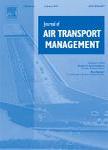版权所有:内蒙古大学图书馆 技术提供:维普资讯• 智图
内蒙古自治区呼和浩特市赛罕区大学西街235号 邮编: 010021

作者机构:Ecole Natl Aviat Civile ENAC 7 Ave Edouard Belin F-31400 Toulouse France King Abdullah Univ Sci & Technol KAUST Thuwal 23955 Saudi Arabia Nanyang Technol Univ NTU 50 Nanyang Ave Singapore 639798 Singapore
出 版 物:《JOURNAL OF AIR TRANSPORT MANAGEMENT》 (J. Air Transp. Manage.)
年 卷 期:2025年第124卷
核心收录:
学科分类:12[管理学] 0202[经济学-应用经济学] 02[经济学] 1201[管理学-管理科学与工程(可授管理学、工学学位)] 020205[经济学-产业经济学] 08[工学] 082303[工学-交通运输规划与管理] 0823[工学-交通运输工程]
基 金:Artificial and Natural Intelligence Toulouse Institute (ANITI)
主 题:Airport security checkpoint Schedule optimization Simulated annealing Integer linear programming Security screening lines Staff allocation
摘 要:Security checkpoints are an important matter of concern for airport operators. When functioning effectively, they not only maintain the airport overall safety at a high level, but also provide passengers with a positive airport experience. The perceived quality of service at the airport greatly depends on the time spent by passengers at the security lines. To ensure optimal safety performance, screening lines have a limited capacity of passengers they can handle. Thus, to prevent extended waiting times for passengers, airports can only adjust the number of simultaneously open check lines. The airport operator must establish optimal schedules for opening security checkpoints and allocating necessary staff. Building upon a prior study focused on predicting the flow of passengers through the security checkpoints, this paper explores simulated annealing algorithm in conjunction with a queue simulator and an integer programming algorithm to establish the most effective opening schedule for security checkpoints based on the prediction given by this previous study. The presented approach also determines the best allocation for dedicated staff based on the forecasted passenger flow. This approach limits the number of open security lines and ensures awaiting time below the maximum limit of 45 min set by the airport. It also complies with the work regulations that security agents are subject to.